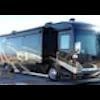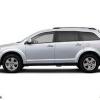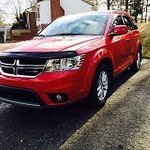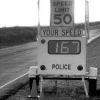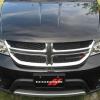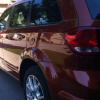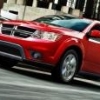-
Posts
282 -
Joined
-
Last visited
-
Days Won
15
Reputation Activity
-
 webslave got a reaction from Journey_SeXT in Felt tube inside the air filter box
webslave got a reaction from Journey_SeXT in Felt tube inside the air filter box
If it were that easy, every manufacturer would include a CAI as stock; they are always looking for ways to boost HP without it costing them anything and a CAI is much cheaper to manufacture than the stock airbox, plumbing and resonators. Your 6-25 HP increases are statistically insignificant (numerically to a statistician) as "background noise" and well within the standard deviation of error based on friction at the wheels, humidity and temperature along with mechanical losses and gains of the dyno itself. Like I said, I used to build cars that developed far more HP and were much more sensitive to input changes. We went so far as to make sure each piston, wrist pin and crank weighed the same (balancing) and coated the piston walls with architectural dye (blue printing) to determine ring scrub...
If it were so simple (the CAI), Ford certainly wouldn't have invested the millions necessary to develop the Ecoboost turbo system. I'll quit; the CAI myth has been debunked by many ASE groups along with the above Myth Busters episode. It produces growl and that's about it. Most of the CAI units actually duct more engine compartment heat into the system (they are open and drafty as all get out on top) than the stock sealed unit that snorkles cold air from ahead of the radiator into the system that is predominately thin plastic (less of a heat transfer medium) than the heavy pipe (absorbs and holds engine bay heat) and thin stamped metal (a radiator of engine heat) that the box is made of in CAI systems. Do you honestly think that BMW, Mazda, Mercedes, etc. would pass up a means of adding 25 or more HP by leaving more expensive equipment off and substituting less expensive components?
End of my involvement...it's your money to spend any way you deem appropriate.
-
 webslave got a reaction from jkeaton in Felt tube inside the air filter box
webslave got a reaction from jkeaton in Felt tube inside the air filter box
If it were that easy, every manufacturer would include a CAI as stock; they are always looking for ways to boost HP without it costing them anything and a CAI is much cheaper to manufacture than the stock airbox, plumbing and resonators. Your 6-25 HP increases are statistically insignificant (numerically to a statistician) as "background noise" and well within the standard deviation of error based on friction at the wheels, humidity and temperature along with mechanical losses and gains of the dyno itself. Like I said, I used to build cars that developed far more HP and were much more sensitive to input changes. We went so far as to make sure each piston, wrist pin and crank weighed the same (balancing) and coated the piston walls with architectural dye (blue printing) to determine ring scrub...
If it were so simple (the CAI), Ford certainly wouldn't have invested the millions necessary to develop the Ecoboost turbo system. I'll quit; the CAI myth has been debunked by many ASE groups along with the above Myth Busters episode. It produces growl and that's about it. Most of the CAI units actually duct more engine compartment heat into the system (they are open and drafty as all get out on top) than the stock sealed unit that snorkles cold air from ahead of the radiator into the system that is predominately thin plastic (less of a heat transfer medium) than the heavy pipe (absorbs and holds engine bay heat) and thin stamped metal (a radiator of engine heat) that the box is made of in CAI systems. Do you honestly think that BMW, Mazda, Mercedes, etc. would pass up a means of adding 25 or more HP by leaving more expensive equipment off and substituting less expensive components?
End of my involvement...it's your money to spend any way you deem appropriate.
-
 webslave got a reaction from rolly in Felt tube inside the air filter box
webslave got a reaction from rolly in Felt tube inside the air filter box
If it were that easy, every manufacturer would include a CAI as stock; they are always looking for ways to boost HP without it costing them anything and a CAI is much cheaper to manufacture than the stock airbox, plumbing and resonators. Your 6-25 HP increases are statistically insignificant (numerically to a statistician) as "background noise" and well within the standard deviation of error based on friction at the wheels, humidity and temperature along with mechanical losses and gains of the dyno itself. Like I said, I used to build cars that developed far more HP and were much more sensitive to input changes. We went so far as to make sure each piston, wrist pin and crank weighed the same (balancing) and coated the piston walls with architectural dye (blue printing) to determine ring scrub...
If it were so simple (the CAI), Ford certainly wouldn't have invested the millions necessary to develop the Ecoboost turbo system. I'll quit; the CAI myth has been debunked by many ASE groups along with the above Myth Busters episode. It produces growl and that's about it. Most of the CAI units actually duct more engine compartment heat into the system (they are open and drafty as all get out on top) than the stock sealed unit that snorkles cold air from ahead of the radiator into the system that is predominately thin plastic (less of a heat transfer medium) than the heavy pipe (absorbs and holds engine bay heat) and thin stamped metal (a radiator of engine heat) that the box is made of in CAI systems. Do you honestly think that BMW, Mazda, Mercedes, etc. would pass up a means of adding 25 or more HP by leaving more expensive equipment off and substituting less expensive components?
End of my involvement...it's your money to spend any way you deem appropriate.
-
 webslave reacted to jkeaton in Felt tube inside the air filter box
webslave reacted to jkeaton in Felt tube inside the air filter box
Yep, they are lying. But for $300 +, they sure do souond cool.
-
 webslave got a reaction from jkeaton in 2010 Windshield loose/noise
webslave got a reaction from jkeaton in 2010 Windshield loose/noise
I don't think it is the windshield being "loose"...if the seal was broken in an area, it would leak, but, wouldn't rattle. That laminated plate glass is very rigid and very heavy. Most likely you have a loose wiring harness or bracket under the headliner that, in very cold temperatures, shrinks a bit and allows a rattle. There are a lot of wires that travel all over the car under that headliner and can rattle in the right conditions. A good dealership can probably track it down, but, my WAG is something under the headliner and not the windshield, especially if it isn't leaking...
Keep us posted on what you find...
-
 webslave got a reaction from jkeaton in New here DODGE JOURNEY 2.0 CRD SXT OWNER - UK
webslave got a reaction from jkeaton in New here DODGE JOURNEY 2.0 CRD SXT OWNER - UK
^^^ Wish they did....I'd be all over it!
-
 webslave got a reaction from SanderVispoel in Felt tube inside the air filter box
webslave got a reaction from SanderVispoel in Felt tube inside the air filter box
Exactly. A lot of us "old timers" built cars (yes, I built race cars in the late '60s and early '70s) and there were many things that "became legend" during those times. More air was one, but, even in those days, more air didn't do you any good until you re-jetted the carburetors or added additional carburetors to add the additional fuel to take advantage of it. To really take advantage of it, you needed to also alter the cam's duration for intake and exhaust, add a bigger exhaust system (headers, straight through pipes, low-flow mufflers, etc) to get rid of the exhaust so that you could get more air and fuel in quicker, etc.
Enter the modern day computer controlled systems. You can put more air in the system, but, it won't use it due to the variable venturi effect of the throttle body. The MAP will only allow the amount air to be used such that the "perfect" air/fuel mixture is maintained. Put more fuel in the mix, the computer will retard the engine and lean the injectors until it evens out. A new cam won't even buy you anything because the computer will again control spark (firing) and fuel (injectors) to maintain its "ideal".
CAI? Sure, it will make your car sound "meaner", but, no real gains in hp or mpg. CAT back exhaust? Again, more noise, the "meaner" sound, but, put it on a dyno and you've got nothing but sound effects. Anything a "shade tree" mechanic can do will do mostly zip for actual "performance"; the best improvements would be gained by turbo charging or putting a blower on it, but, that involves re-engineering the heads and block and re-programming of the computer to take advantage of the added compression ratios. I had a Jeep Commander with the Hemi and went that route just playing around. Had it dyno tested before and after. Zero change in hp at the wheels and zero change in long range fuel economy; in fact short range fuel economy suffered for awhile because "putting my foot in it" made it sound so much better...didn't go faster, it just sounded like it was. I actually, after about a year, put the stock air box and snorkel back on and re-installed the stock exhaust so that I had back the "peace and quiet" of the original Commander; without any performance enhancement the noise was irksome. I had forgotten all that I had learned building cars in the good old days.
Lesson learned? Yes you can tear the stock air cleaner off and install a CAI that will sound meaner, but, require more maintenance than the stock unit for no gains except noise. You can install a CAI for the added noise and possibly incur a short lifespan on the exhaust parts, but, again, no real gains. Until and unless you do something with the computer, it will regulate the "simple changes" so that there are no changes. Start messing with the computer and you can actually destroy the engine - check some of the diesel folks and their "extreme" tuners and the FEDS have stepped in so that those tuners are now regulated or banned for emission reasons. There are some things you can do for "improvement"; those of you without the larger brakes could upgrade the rotors and calipers. Those of you that don't like the ride can experiment with various spring packages and shocks, but, over-all "performance" is governed by the computer and the computer is quite capable of changing enough parameters that anything else you do will be either no gain, or engine damaging. The engineer's of today's vehicles do everything they can to "balance" hp, comfort and efficiency (mpg) and there really are no "miracle" cures that you can add off the shelf as a "bolt on" addition.
-
 webslave got a reaction from jkeaton in Felt tube inside the air filter box
webslave got a reaction from jkeaton in Felt tube inside the air filter box
Exactly. A lot of us "old timers" built cars (yes, I built race cars in the late '60s and early '70s) and there were many things that "became legend" during those times. More air was one, but, even in those days, more air didn't do you any good until you re-jetted the carburetors or added additional carburetors to add the additional fuel to take advantage of it. To really take advantage of it, you needed to also alter the cam's duration for intake and exhaust, add a bigger exhaust system (headers, straight through pipes, low-flow mufflers, etc) to get rid of the exhaust so that you could get more air and fuel in quicker, etc.
Enter the modern day computer controlled systems. You can put more air in the system, but, it won't use it due to the variable venturi effect of the throttle body. The MAP will only allow the amount air to be used such that the "perfect" air/fuel mixture is maintained. Put more fuel in the mix, the computer will retard the engine and lean the injectors until it evens out. A new cam won't even buy you anything because the computer will again control spark (firing) and fuel (injectors) to maintain its "ideal".
CAI? Sure, it will make your car sound "meaner", but, no real gains in hp or mpg. CAT back exhaust? Again, more noise, the "meaner" sound, but, put it on a dyno and you've got nothing but sound effects. Anything a "shade tree" mechanic can do will do mostly zip for actual "performance"; the best improvements would be gained by turbo charging or putting a blower on it, but, that involves re-engineering the heads and block and re-programming of the computer to take advantage of the added compression ratios. I had a Jeep Commander with the Hemi and went that route just playing around. Had it dyno tested before and after. Zero change in hp at the wheels and zero change in long range fuel economy; in fact short range fuel economy suffered for awhile because "putting my foot in it" made it sound so much better...didn't go faster, it just sounded like it was. I actually, after about a year, put the stock air box and snorkel back on and re-installed the stock exhaust so that I had back the "peace and quiet" of the original Commander; without any performance enhancement the noise was irksome. I had forgotten all that I had learned building cars in the good old days.
Lesson learned? Yes you can tear the stock air cleaner off and install a CAI that will sound meaner, but, require more maintenance than the stock unit for no gains except noise. You can install a CAI for the added noise and possibly incur a short lifespan on the exhaust parts, but, again, no real gains. Until and unless you do something with the computer, it will regulate the "simple changes" so that there are no changes. Start messing with the computer and you can actually destroy the engine - check some of the diesel folks and their "extreme" tuners and the FEDS have stepped in so that those tuners are now regulated or banned for emission reasons. There are some things you can do for "improvement"; those of you without the larger brakes could upgrade the rotors and calipers. Those of you that don't like the ride can experiment with various spring packages and shocks, but, over-all "performance" is governed by the computer and the computer is quite capable of changing enough parameters that anything else you do will be either no gain, or engine damaging. The engineer's of today's vehicles do everything they can to "balance" hp, comfort and efficiency (mpg) and there really are no "miracle" cures that you can add off the shelf as a "bolt on" addition.
-
 webslave reacted to jkeaton in Felt tube inside the air filter box
webslave reacted to jkeaton in Felt tube inside the air filter box
Why dont you go ahead and remove it,. drive through a tankful of gas and see if it improves your mileage? I think it has been stated before, if the engineers who designed the car thought it would provide any benefit by not having it there, it would not be there. More air to the engine wont do anything for you without more fuel. The stoichiometric mixture for a gasoline engine is the ideal ratio (15:1) of air to fuel to allow all fuel to be burned with no excess air. The computer maintains the 15:1 ratio all the time regardless of how much or little air enters the intake manifold. That little felt piece does nothing to alter this.
-
 webslave got a reaction from Journey_SeXT in Felt tube inside the air filter box
webslave got a reaction from Journey_SeXT in Felt tube inside the air filter box
The way engineers are focused on "quiet" nowadays, that could, indeed be the reason they are there or it could be that you just haven't run into the .2% of the reason it is there, yet. The same physics that are at work that allows the felt to keep water from being sucked in (slows the air velocity at the intake) would also keep the air's intake sound down. My Austin didn't have a quiet bone in its body, so, that wasn't the reason for them in that car LOL, but, I just wanted to issue a "caution" on arbitrarily removing things that don't to seem to have a reason for being there. With the cost of vehicles being so important to the manfacturers, they don't add things that don't have a good reason for being there. These cars are rather expensive to take much of a gamble with and I don't imagine that removing them has any benefits in performance or economy since the computer ultimately controls the amount of air that the engine uses and adjusts air/fuel ratio and speed (variable throttle bodies) accordingly. That ability is why the air filter change interval is so long now; the computer can adjust the air/fuel ratio so well that it can run quite efficiently on a partially clogged filter; 3 years or 30,000 miles now between filter changes, a far cry from the "good old days". I don't imagine a CAI unit has them, but, the CAI would be engineered to not need them...that doesn't infer that the stock air box doesn't, since from what I've been hearing, that airbox is "standard" across several versions of this engine and several models of cars with minor differences in the snorkels and piping and it may be that the DJ needs it and others don't due to snorkel design and that isn't something that a salesman or even service technician would know. There's a big difference in selling and servicing when compared to engineering systems and sub-systems.
I'll wait to see what the engineers say, if one of them replies, before I start removing things without a replacement device. I wouldn't remove the air box without adding some sort of replacement, i.e., a CAI unit, so, until I find out exactly why Chrysler put that in, I'll leave it there since it doesn't hurt anything and doesn't improve anything by removing it. Ultimately though, it is your gamble and any time we gamble it is up to each of us as to whether we roll the dice or ask for cards.
-
 webslave got a reaction from Journey_SeXT in Felt tube inside the air filter box
webslave got a reaction from Journey_SeXT in Felt tube inside the air filter box
Might be a little careful about removing it... I had an Austin Healey once and it had similar attachments to its dual Stromberg carbs. I was going to do away with them as they looked pretty ratty (old car), but, I knew a guy that was retired from the British Emabassy; their chief mechanic, and boy did he come in handy with that vehicle. Anyway, he said they (the felt wraps) were on the intakes to keep liquid water from being inhaled into the intakes. Turns out that the intake snorkel was level and pointed straight ahead. According to him that if following a car closely or a large splash occurred in front of the snorkels that water could enter the housing. The housing had drain holes, but, he said that it was possible that a large enough volume of water could enter and not drain rapidly enough out. The felt was used to absorb the liquid while allowing air to pass through, preventing hydraulic lock from happening in a cylinder...
I haven't even looked at my DJ's intake system, I'm not interested in CAI (I've been that direction on other cars and except for the sound, there was no other gains, hp or mpg, the car's computer regulates all of the input variables and more air doesn't buy you anything as the computer will make changes to the others to keep it in "trim") and it isn't anywhere near time for a filter change, so, I'm not real sure why Chrysler put those in, but, I do know why they were on my old Austin and I'm guessing Chrysler wouldn't have gone to the expense if they didn't know something... You could probably remove it and be good to go 99.8% of the time, but, if I had to guess, Chrysler put that on there for the other .2% and hydraulic cylinder lock does some really devastating damage to the rods, crank and block.
You might want to wait to see if the Chrysler Cares folks have some technical insight before removing them...
-
 webslave got a reaction from rolly in Felt tube inside the air filter box
webslave got a reaction from rolly in Felt tube inside the air filter box
Might be a little careful about removing it... I had an Austin Healey once and it had similar attachments to its dual Stromberg carbs. I was going to do away with them as they looked pretty ratty (old car), but, I knew a guy that was retired from the British Emabassy; their chief mechanic, and boy did he come in handy with that vehicle. Anyway, he said they (the felt wraps) were on the intakes to keep liquid water from being inhaled into the intakes. Turns out that the intake snorkel was level and pointed straight ahead. According to him that if following a car closely or a large splash occurred in front of the snorkels that water could enter the housing. The housing had drain holes, but, he said that it was possible that a large enough volume of water could enter and not drain rapidly enough out. The felt was used to absorb the liquid while allowing air to pass through, preventing hydraulic lock from happening in a cylinder...
I haven't even looked at my DJ's intake system, I'm not interested in CAI (I've been that direction on other cars and except for the sound, there was no other gains, hp or mpg, the car's computer regulates all of the input variables and more air doesn't buy you anything as the computer will make changes to the others to keep it in "trim") and it isn't anywhere near time for a filter change, so, I'm not real sure why Chrysler put those in, but, I do know why they were on my old Austin and I'm guessing Chrysler wouldn't have gone to the expense if they didn't know something... You could probably remove it and be good to go 99.8% of the time, but, if I had to guess, Chrysler put that on there for the other .2% and hydraulic cylinder lock does some really devastating damage to the rods, crank and block.
You might want to wait to see if the Chrysler Cares folks have some technical insight before removing them...
-
 webslave got a reaction from Journey Dude in Dodge journey tire pressure
webslave got a reaction from Journey Dude in Dodge journey tire pressure
My guess is that you are looking at the pressure for the spare tire... The temporary spares that vehicles come with now are usually inflated in the 50-60 psi range. Your regular tires though should be more in the 36 psi range. My RAM pickup with the Cummins Turbo Diesel requires 60 psi to support that weight, but, the Journey wouldn't come anywhere close...
2 psi over won't affect anything at all. May harshen the ride a bit, but, IMHO, you won't know the difference and it would keep the tread flatter on the road while keeping the sidewalls a bit stiffer.
-
 webslave got a reaction from air1rfc in POOR HANDLING IN ICY CONDITIONS
webslave got a reaction from air1rfc in POOR HANDLING IN ICY CONDITIONS
I have, over the years, had them all...single rear drive, dual rear drive (positraction), fwd, fwd with stability (front axle locking), AWD, 4WD and full-time 4WD (Jeep QuadraTrac I and II). 4WD is fine, but, you have to shift to get into it, and not all 4WD units are on-the-fly shift enabled. By the time you know you need it, in some instances, it is too late, other times you have to either slow or stop to enable it and then continue on and then slow or stop to disable it when the roads firm up (most 4WD units lead very short lives if run on dry pavement). When the roads are variable, dry patches with slick intermixed, 4WD is less suitable for those changing conditions.
The best in my book was the QuadraTrac system. Full time 4WD...all the time. My Jeeps have been like tanks; they just go, no pausing, no slipping, just traction if traction was available. For most of us, though, the modern AWD system is quite sufficient. Lighter weight when compared to 4WD systems and no thought involved. You get into a slippery condition where traction for each wheel is variable and constantly changing and the AWD is there to get you through the problem by putting the majority of the torque on the wheel that has traction enough to use it and being able to change the driving wheel almost instantaneously and seamlessly. You don't have to think about it, you don't have to plan around it, it is just there when you need it automatically, most of the time, you don't even realize it is happening. If you don't need it, the JD's AWD defaults to a standard FWD system for fuel mileage. Is it off-road suitable? No, 4WD is much better at rock climbing, mud, etc., but, most of us don't off-road (I have a 4WD truck for that) and most of us stay off roads that 4WD would prove more suitable than AWD. Having had both, I've not found a road condition that my AWD hasn't handled as well as my 4WD Commander did. Have there been roads that were better left to 4WD? Yep, but, when the roads are that bad, I stay off of them until they are plowed or the depth is 6 inches or less and my AWD is quite suitable at that point. I got rid of my Commander (full time 4WD) because of my confidence in the MOPAR AWD system and its ability to go when I need to go, tempered by my own sense of when to be on a road and when I should be parked at home. Shouldn't cause any driver confusion; the driver doesn't have to do anything (unlike 4WD) or plan ahead; they just have to drive with a modicum of common sense and the car's system will handle the "go" part. I know I don't even think about it; it is there when the road condition warrants it and I don't have to do anything to make it happen.
-
 webslave got a reaction from jkeaton in Can I tow it???
webslave got a reaction from jkeaton in Can I tow it???
I do a fair amount of towing... My considered opinion? Don't try it. Despite what a lot of people say/think, the DJ is not a truck, is not even an SUV and it doesn't have the underpinnings or hardware necessary for that type of towing for that long of a distance. While the DJ can be equipped with a "Tow Package" (and I'm guessing yours isn't?), it is still aimed at towing small boats or utility trailers with some mulch or a dirt bike on it, not for long distance towing with a bordline overloaded vehicle and load... There are a couple of folks on this forum that tow pop-up campers, but, those are considerably lighter than your Scion and the DJ's aren't as loaded as what you are describing. I'll put a trailer hitch on my DJ, but, only to hold my bicycle rack. Any other towing is done by my RAM 2500 CTD.
-
 webslave got a reaction from rolly in Can I tow it???
webslave got a reaction from rolly in Can I tow it???
I do a fair amount of towing... My considered opinion? Don't try it. Despite what a lot of people say/think, the DJ is not a truck, is not even an SUV and it doesn't have the underpinnings or hardware necessary for that type of towing for that long of a distance. While the DJ can be equipped with a "Tow Package" (and I'm guessing yours isn't?), it is still aimed at towing small boats or utility trailers with some mulch or a dirt bike on it, not for long distance towing with a bordline overloaded vehicle and load... There are a couple of folks on this forum that tow pop-up campers, but, those are considerably lighter than your Scion and the DJ's aren't as loaded as what you are describing. I'll put a trailer hitch on my DJ, but, only to hold my bicycle rack. Any other towing is done by my RAM 2500 CTD.
-
 webslave got a reaction from Ronin'sParents in Fuel Guage Wont READ PAST FULL
webslave got a reaction from Ronin'sParents in Fuel Guage Wont READ PAST FULL
The gauge is electronic...subject to being calibrated to the voltage put out by the tank sensor. Different calibration voltages yield different needle positions. Yours is just calibrated better than hers. If yours reads "full" and not more than full, then, when your needle says you have half a tank you are much more likely to have 10 gallons than she is, all things being equal. When hers reads a half a tank, she'll have less than 10 gallons. Her true half tank point would be the same distance above the half tank mark as her full tank indicator is above the full indicator line.
A full tank should read a "full tank". Nothing more or nothing less; full is 20 gallons (the size of the tank) and isn't changed by the needle's position on the gauge - that's calibration.
-
 webslave reacted to OhareFred in Rattling in middle row?
webslave reacted to OhareFred in Rattling in middle row?
I usually don't comment on things like this but unless you NEVER use the rear seats, you could be placing someone in extreme danger in the event of an accident. Head rests are not there to rest your head, but to act as a safety device to prevent or minimize head and neck trauma in the event of an accident. It doesn't take much to cause major neck trauma which could result in paralysis! Even small children or adults will benefit from them. Is it more important to see where you have been or to protect those in the seats?
Ok, I'm off my high horse and done with the lecture! Thank you for reading, take it for what you will!
Be Safe.
-
 webslave got a reaction from Rgwog in Fuel Guage Wont READ PAST FULL
webslave got a reaction from Rgwog in Fuel Guage Wont READ PAST FULL
The gauge is electronic...subject to being calibrated to the voltage put out by the tank sensor. Different calibration voltages yield different needle positions. Yours is just calibrated better than hers. If yours reads "full" and not more than full, then, when your needle says you have half a tank you are much more likely to have 10 gallons than she is, all things being equal. When hers reads a half a tank, she'll have less than 10 gallons. Her true half tank point would be the same distance above the half tank mark as her full tank indicator is above the full indicator line.
A full tank should read a "full tank". Nothing more or nothing less; full is 20 gallons (the size of the tank) and isn't changed by the needle's position on the gauge - that's calibration.
-
 webslave got a reaction from Journey_SeXT in Fuel Guage Wont READ PAST FULL
webslave got a reaction from Journey_SeXT in Fuel Guage Wont READ PAST FULL
The gauge is electronic...subject to being calibrated to the voltage put out by the tank sensor. Different calibration voltages yield different needle positions. Yours is just calibrated better than hers. If yours reads "full" and not more than full, then, when your needle says you have half a tank you are much more likely to have 10 gallons than she is, all things being equal. When hers reads a half a tank, she'll have less than 10 gallons. Her true half tank point would be the same distance above the half tank mark as her full tank indicator is above the full indicator line.
A full tank should read a "full tank". Nothing more or nothing less; full is 20 gallons (the size of the tank) and isn't changed by the needle's position on the gauge - that's calibration.
-
 webslave got a reaction from Rgwog in First service for new (to me) Journey R/T
webslave got a reaction from Rgwog in First service for new (to me) Journey R/T
Sounds awfully excessive to me. Just checked my manual...
Spark plugs aren't due until 160,000 km
Have no idea what their "induction service" includes, but, I suspect it is injector cleaning. If so, and car is running evenly, pass on that. Those injectors are tough and normally will last the length of ownership. If not, then deal with one or more of them if, and when, they fail. I had a friend that had his injectors "cleaned". Car never ran right afterwards. Not, that is, until he replaced all the injectors with new units to get it to run right again.
Are your struts bad? If not, why replace them? Are you having alignment issues? Handling issues? Again, pass, until such time as something fails.
Fluids: Coolant at 160,000 km, Transmission at 192,000 km unless used for taxi, fleet or severe towing service., AWD components: 96,000 km.
So, unless you are having "issues" with the suspension components and they need to be repaired (there isn't a "service" interval - they run till they break), all you might need is oil, even your air filter is not due until 96,000 km. Maybe the dealer has a mortgage payment he needs to meet and cash flow is low...
To do a lot of that just because it has 80,000 km on it is nonsense. You could spend thousands to make the car "like new" and never get it to "like new". I've got a 1976 Cadillac Eldorado that I still drive; 98% all original parts, even the suspension (did replace the rear shocks when the auto-level pump failed and I couldn't find a replacement). I've got a 1989 Chrysler LeBaron with the original transmission, rear end, and brake fluid still in it. All original; put new disc pads front and rear on it once, routine oil and filters and two sets of tires. Still have the original spark plugs in it.
I'd definitely have another shop take a look at it. Failed parts need to be replaced, worn (wearing is part of "failing") is not a reason to replace them, neither is age. Back in the '50's and '60's, cars were considered "good" if they lasted 36,000 miles before needing major work...now, 200,000 miles is "normal" and my son was driving my '96 Grand Caravan until last year; 300,000 miles before a part failed and that part cost more than the poor minivan was worth...
-
 webslave got a reaction from Journey_SeXT in new noise from K&N?
webslave got a reaction from Journey_SeXT in new noise from K&N?
Years ago I used K&N filters to save money since I could get a lot longer service life out of them than the stock paper models. However, in today's newer systems I've found that not to always be true. With the 13's replacement schedule of 30,000 miles I can live with the cost of buying one and chucking it every three years. I don't have to worry any more about periodically removing the K&N and cleaning it and re-oiling it. With the new computer systems in the intake system, K&N doesn't really gain you anything as the computer will automatically make the adjustments to the fuel injectors based on air supply, getting an "easier breathing engine" with today's systems doesn't apply any longer. You get a different sound and that leads to many thinking of "great gobs of power" and "gee, it's got to get better mileage", but, the reality is far less impressive. In fact, over-oiling your filter will cut your air intake. You would need to re-program your computer to take advantage of any flow improvement and that really is a warranty killer. Back in the carburetor days, easy breathing, better exhaust scavenging coupled with appropriate changes to carburetor needles could yield improvements in everything from horsepower to mileage, but, in today's computer controlled fuel and ignition systems, the computer already wrings just about everything that can be gotten out of new engines.
The new systems are geared for the paper filters, a 30,000 mile replacement is pretty cheap, the warranty is based on the paper usage, there's no cleaning and re-oiling with the paper (even when I was a K&N fan, the extra work always annoyed me). What's not to like. Don't get me wrong, I used to be a K&N fan, and for some applications, I still am, but, with today's computer derived fuel management and longer service life of the stock elements, I don't see any advantage to using them with most modern vehicles. With warranty issues being what they are, why should I give the dealer any ammunition at all if there isn't a large and overwhelming reason to...and I don't see the "large and overwhelming" reasons to use the K&N filter at all, either while the warranty is in effect or after it has expired.
If you want K&N, by all means go that route, but, with today's new systems, longer service intervals and the intended use of my DJ (face it, a Challenger it isn't), I, for one will stick with the paper filters.
-
 webslave reacted to Rgwog in Holster
webslave reacted to Rgwog in Holster
Come on Red lighten up a tick. Every one has the right to protect your self. Even though I dont carry mine everywhere I go. A gun locked away in a lock box at home doesnt do much good. It is a tool and when used correctly will serve its purpose. Mkatona make sure to check local laws about carry in vehicles. I have seen modified holsters mounted under the steering column. but on the hip is the best place.
-
 webslave reacted to Windancer in Towing
webslave reacted to Windancer in Towing
This seems to be one of the biggest "bones of contention" with our Journeys. I know for 2009 & 2010 the manual suggests 3500# and the newer ones suggest only 2500#, I'll state right up front I AM NO EXPERT but as Journeyman425 said before me said He will not publicly condone towing over the limit, but the car seems more thancapable of towing more than it says. Now do you want to take that chance?
As DodgeCaCares states there are many things that are factored into a tow rating and it is a very good guideline to follow. It is not a Ram Truck so don't expect it to be.
Terry
-
 webslave got a reaction from rolly in Dealer says it can't be done
webslave got a reaction from rolly in Dealer says it can't be done
The "unit" I was talking about is the DJ that I own... "Unit" in this context just means a car produced at a factory, a unit of that factory's production. As for "resetting" a unit or component, it just means "refreshing" the software; kind of like a "system restore" in Windows. It clears the settings and resets them to the factory defaults. If you "reset" your UConnect unit (CPU), you will lose your stored radio stations or anything else that is stored on "temporary" memory. It won't delete your songs on a USB stick or memory card, but, you will lose your equalizer settings or any other custom settings; door lock preference, headlight "on" time, etc. Easily reset. If they reset the PCM, you will lose "stored" driving style habits, etc. Your DJ will have to go through the "learning" curve again; still not a big issue. The same things will happen when you put a new battery in unless you take care to have a "jumped" alternate power source hooked up to keep power on the individual CPUs in the car. In fact, one of the first things that most dealers will do if you report "strange" behaviour attributable to one of the logic systems is to disconnect the battery, wait a minimum of 30 seconds, better a couple of minutes, and then hook the system back up. That "resets" all of the systems in the car and they re-establish communications with each other ("handshakes" in the industry) and will quite often correct any errors that are communication issues and not hardware failures. I made the final fix on the display of the compass in my DJ by doing it. I didn't have the direction letters in the 8.4 system even though the dealer got them to display in the EVIC (they were absent, too, when I first picked it up). I pulled the power (disconnected the battery) for 5 minutes and reconnected the cable. The EVIC and the 8.4 UConnect restored fresh communications and in the process the UConnect realized that it was receiving directional information and promptly displayed that information on the bottom of the screen, instead of a blank, empty icon, it now had the directional letters inside it.
When they "reset" the units (computer - PCM and BCM) on my Commander, after going to "Canadian" for "Home", to enable the DRLs, it was to get the units to display units in English units and not metric. They could have left in Canadian, but, then my speedo would have been in KPH and my fuel gauges would have been in liters. "Resetting" the "unit" (the Jeep) to US, put all the reporting back to US units of measurement. I lost all of my settings; radio stations, equalizer settings, etc. but, not the information (music) stored on the MyGig hard drive. A nuisance to go back in and reset my "preferences", but, it only takes a couple of minutes and was worth the effort. In fact, I (with the dealership) did so much messing around with the software, via the StarScan tool, that resetting my preferences became almost a habit! The systems in the car are just little "computers", nothing magical, most aren't any more sophisticated than your smart phone. It is a shame that the StarScan tool is so expensive...I'd buy one just to be able to "poke around" Of course, I'd need the full set of backup software CDs in case I did an "oops"...


